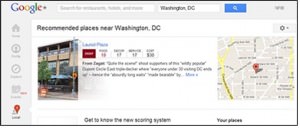While scoring high on the search engine results pages isn’t a concern for people operating personal websites, when you’re running a site with commercial goals, you want to be easy to find through search engines. You can make a dramatic difference in your ranking with a little bit of google places business optimization (Google Local Optimization). There are experts out there who’ll charge you big money for Google Local Optimization work, but you can have a big impact all on your own. Here’s how.
Quick and Effective Google Places Business Optimization Tips
 To do good Google Local Optimization work, you have to know what keywords to focus on. This means getting comfortable with Google’s AdWords keyword tool. Sign up for an AdWords account. Don’t worry, you can use the keyword tool free of charge. It’ll let you see how many searches are done for words and phrases related to your website’s subject. You can pick keywords you want to optimize for on your site based on overall traffic and the potential level of competition you’ll be facing.
To do good Google Local Optimization work, you have to know what keywords to focus on. This means getting comfortable with Google’s AdWords keyword tool. Sign up for an AdWords account. Don’t worry, you can use the keyword tool free of charge. It’ll let you see how many searches are done for words and phrases related to your website’s subject. You can pick keywords you want to optimize for on your site based on overall traffic and the potential level of competition you’ll be facing.
Once you’ve selected a few keywords, you’re ready to start tweaking the pages on your site to include them more often and more prominently. Each page should have one keyword that best suits its content. The first place you want to include this keyword is in the page’s title tag. Title tags are heavily weighted by the search engines, so getting your chosen keyword in here is very important.
Powerful Google Local Optimization tool
It goes without saying that you’ll want your chosen keyword to appear in the page’s content. Don’t go overboard; repeating your keywords too many times makes your pages hard to read. Search engines can also tell when keywords make up a large percentage of the text on a page, and it sets off warning bells. One Google Local Optimization tactic that many people overlook is including their keyword in the URL of the page. This adds another instance of the keyword to your overall total, and it also makes your site map a more powerful Google Local Optimization tool.
The final touch to your page’s Google Local Optimization work is a good meta description. Contained in the HTML meta tag, your page’s description will generate the short preview that appears beneath the page’s listing on the search engine results page. While you want your meta description to include your chosen keywords, you also want it to be informative and interesting to real people. Remember, you don’t just want to show up early in people’s searches; you want them to click on the link to your site, too!
Finally, here are a few simple Google Local Optimization pitfalls to avoid. Duplicate content is dangerous. Don’t use the same text over and over, especially in large chunks. Don’t let your site contain duplicate pages, either; make sure you’re not publishing the same page under two different URLs. When you remove a page from your site, don’t just delete the entire thing. Make sure there’s a redirect in place that points people to a more appropriate page. Redirects will ensure that your Google Local Optimization work doesn’t go to waste.
Although it does take a little effort to raise your search engine ranking, it’s not really a complicated process. You can easily learn the basic techniques of google places business optimization, such as those presented above. Incorporating them into your site will have a definite positive effect on its search engine performance, and doing your own basic Google Local Optimization work will soon become second nature to you.